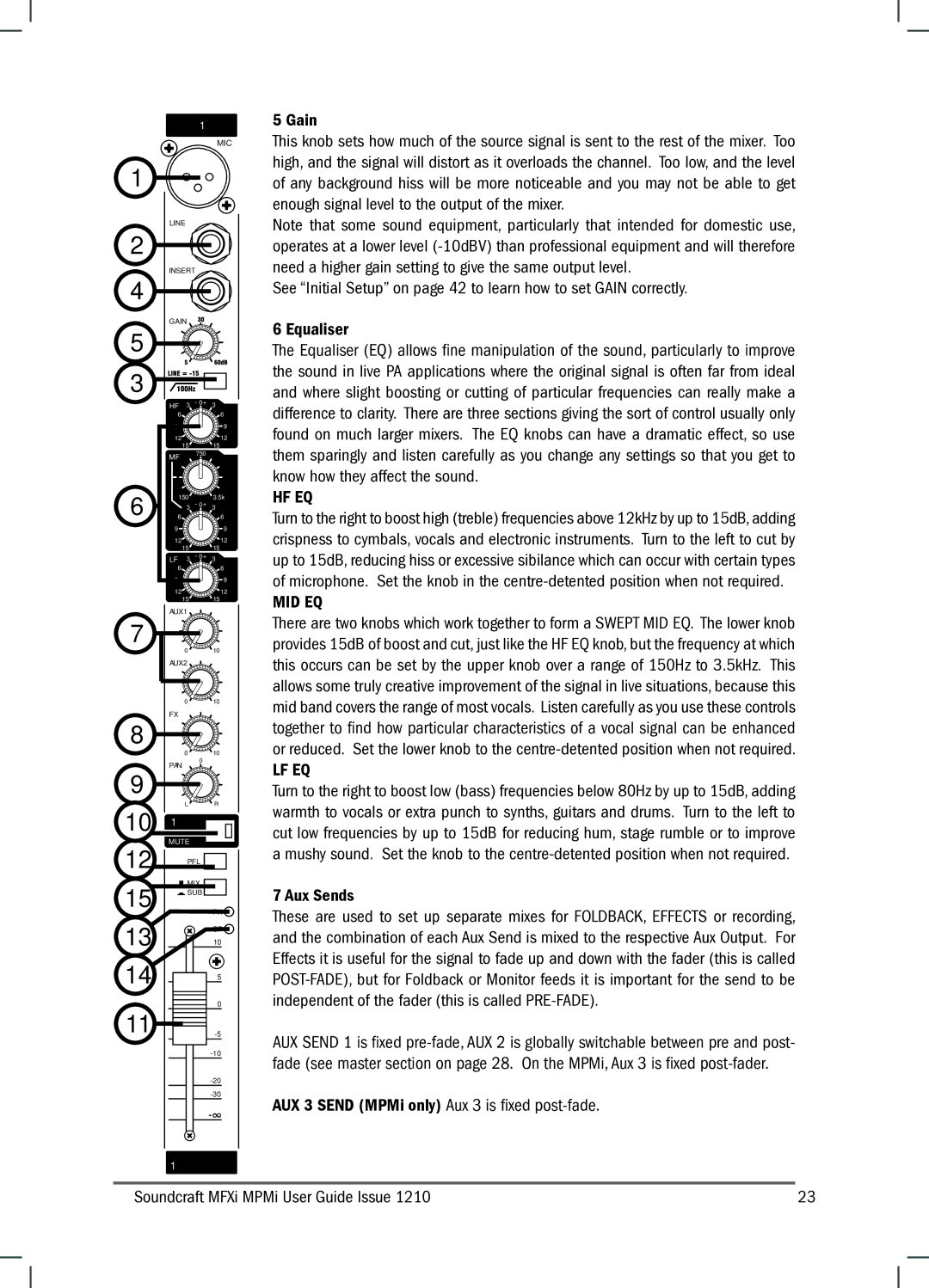
|
|
| 1 |
|
|
| MIC |
1 |
|
|
|
| LINE |
| |
2 |
|
|
|
| INSERT |
| |
4 |
|
|
|
| GAIN |
| |
5 |
|
|
|
3 |
|
|
|
| HF | 3 | - 0+ 3 |
| 6 |
| 6 |
| 9 |
| 9 |
| 12 |
| 12 |
|
| 15 | 15 |
| MF |
| 750 |
|
|
| |
6 | 150 | 3.5k | |
| 3 - 0+ 3 | ||
6 |
| 6 | |
|
| ||
| 9 |
| 9 |
| 12 |
| 12 |
|
| 15 | 15 |
| LF | 3 | - 0+ 3 |
| 6 |
| 6 |
| 9 |
| 9 |
| 12 |
| 12 |
|
| 15 | 15 |
| AUX1 |
| |
7 |
|
|
|
|
| 0 | 10 |
| AUX2 |
| |
|
| 0 | 10 |
| FX |
|
|
8 |
|
|
|
|
| 0 | 10 |
| PAN |
| 0 |
|
|
| |
9 |
|
|
|
|
| L | R |
10 | 1 |
|
|
|
|
| |
| MUTE |
| |
12 |
| PFL | |
|
|
| |
|
| MIX | |
15 |
| SUB | |
|
|
| |
|
|
| PK |
13 |
|
| SP |
|
| 10 | |
14 |
|
| 5 |
|
|
| |
|
|
| 0 |
11 |
|
| |
|
|
| |
|
|
| |
|
|
| |
|
|
| |
| 1 |
|
|
5 Gain
This knob sets how much of the source signal is sent to the rest of the mixer. Too high, and the signal will distort as it overloads the channel. Too low, and the level of any background hiss will be more noticeable and you may not be able to get enough signal level to the output of the mixer.
Note that some sound equipment, particularly that intended for domestic use, operates at a lower level
See “Initial Setup” on page 42 to learn how to set GAIN correctly.
6 Equaliser
The Equaliser (EQ) allows fine manipulation of the sound, particularly to improve the sound in live PA applications where the original signal is often far from ideal and where slight boosting or cutting of particular frequencies can really make a difference to clarity. There are three sections giving the sort of control usually only found on much larger mixers. The EQ knobs can have a dramatic effect, so use them sparingly and listen carefully as you change any settings so that you get to know how they affect the sound.
HF EQ
Turn to the right to boost high (treble) frequencies above 12kHz by up to 15dB, adding crispness to cymbals, vocals and electronic instruments. Turn to the left to cut by up to 15dB, reducing hiss or excessive sibilance which can occur with certain types of microphone. Set the knob in the
MID EQ
There are two knobs which work together to form a SWEPT MID EQ. The lower knob provides 15dB of boost and cut, just like the HF EQ knob, but the frequency at which this occurs can be set by the upper knob over a range of 150Hz to 3.5kHz. This allows some truly creative improvement of the signal in live situations, because this mid band covers the range of most vocals. Listen carefully as you use these controls together to find how particular characteristics of a vocal signal can be enhanced or reduced. Set the lower knob to the
LF EQ
Turn to the right to boost low (bass) frequencies below 80Hz by up to 15dB, adding warmth to vocals or extra punch to synths, guitars and drums. Turn to the left to cut low frequencies by up to 15dB for reducing hum, stage rumble or to improve a mushy sound. Set the knob to the
7 Aux Sends
These are used to set up separate mixes for FOLDBACK, EFFECTS or recording, and the combination of each Aux Send is mixed to the respective Aux Output. For Effects it is useful for the signal to fade up and down with the fader (this is called
AUX SEND 1 is fixed
AUX 3 SEND (MPMi only) Aux 3 is fixed
Soundcraft MFXi MPMi User Guide Issue 1210 | 23 |
